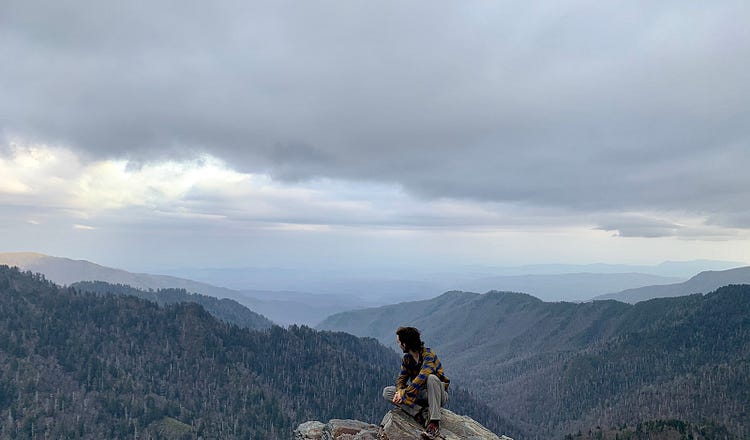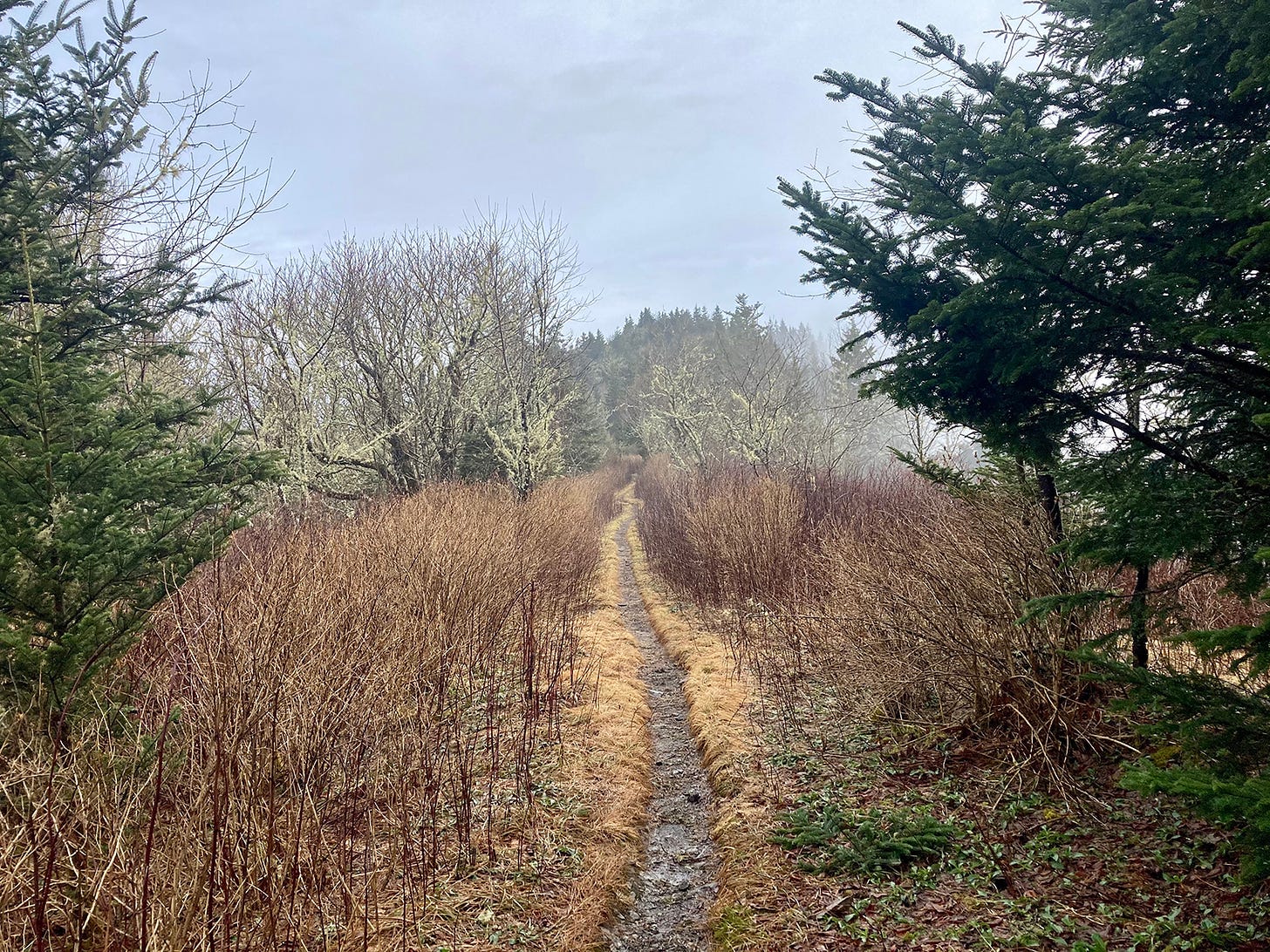
After two of the most deranged weeks in American history, we figured you’d need a break. It is summer, after all. So, today, we’re bringing you an Into the Wild special, all about that most American instinct: taking off into the woods all alone with a slightly crazy ambition.
Escaping is hard at the moment—you turn off your phone for ten minutes, and more horrifying news breaks—but not as hard as it was in 2020. That’s when Free Press intern Elias Wachtel turned 18, mid-Covid. Most of his generation spent the first months of adulthood sitting in their parents’ basements, on their PlayStations. To Elias, this did not appeal. In fact, he wanted to do something that was the very opposite. He wanted to walk the entire length of the Appalachian Trail, all alone, before he started college.
And guess what? He did it. And today is the third anniversary of the day he completed the trail. Below is his uplifting account of the 2,193 mile hike from Georgia to Maine—which, for him, included a brush with hypothermia, some very unlikely friendships, and a love affair with the American landscape.
We’re also bringing you the tale of another man who retreated to the wilderness with a madcap scheme. Peter Gregg wanted to make the perfect maple syrup—and in pursuit of sappiness he, like Elias, risked, if not life, then limb. Scroll down to find an exclusive excerpt of his new memoir, The Sugar Rush—about how “sugaring,” which started as a hobby, became his obsession.
Enjoy! And happy summer.
When I was 18 years old, I decided to hike all 2,193 miles of the Appalachian Trail, from Georgia to Maine.
It was a strange year to come of age, 2020. Covid had canceled my high school graduation and delayed my freshman year of college; it was hard to see how to go out into the world and grow up. But from my bedroom in the suburbs of Chicago, there was an image I couldn’t get out of my head, a memory from a childhood trip in Vermont: little carved signs pointing out a path through the woods. Turn one way, and you could walk to Georgia. Turn around, and you could walk to Maine.
The Appalachian Trail’s length is about 9 percent of the Earth’s circumference and, in terms of elevation, equivalent to hiking up and down Mount Everest sixteen times. It was stitched together in the ’20s and ’30s for local recreation, not for long-distance backpacking: To hike its entirety, to be a “thru-hiker,” was originally thought impossible.
But in 1948, a WWII veteran named Earl Shaffer saw the newly-completed trail as a chance to “walk off the war.” After four long months, he stood atop Mount Katahdin in Maine, and an American tradition was born. Every year, thousands of hikers arrive at the trail’s southern terminus, on Springer Mountain in Georgia, hoping to follow in his footsteps. Only about 20 percent make it to the end; the rest get injured, sick, or give up.
I wanted to prove to myself I could do something most people couldn’t, and could do it all on my own. I’d never camped for more than a few days at a time, and never alone, but in February of 2021, I arrived at the foot of Springer, my eyes set on Maine. The journey would take five or six months. My pack—which held everything I would need to live on trail—felt heavier than it had in my living room. Click here to continue reading…

Blossom Road is a winding dirt road, the last left turn off New York Route 153 before you hit the Vermont state line. In the spring, when the frost gives way, the mud ruts get so deep you can barely get through in a pickup truck. Sometimes the highway crew will take pity on us and spread gravel over the worst sections, but either way Blossom Road is treacherous at this time of year—which is unfortunate, because this is sugaring season.
In a fifteen-mile radius of Blossom Road, there are probably 200,000 tapped maple trees, and two dozen sugarmakers. This includes a private equity millionaire who bought the maple-rich backside of Mount Equinox a few years ago and hired a crew to install 120,000 taps. The rest of us are farmers. And even though we’re technically competitors, we go out of our way to help each other out, which is what farmers do.

I require the most help because I’m a flatlander, which is what people here call you if you come from pretty much anywhere else. I’m from Minnesota, as flat as they come. After moving to Vermont for college, I started producing maple syrup as a hobby in the late ’90s. Meanwhile, my neighbors have been sugaring here all their lives, tending these forests, tapping these trees, and learning maple trade secrets passed down through the generations.
During the messy transition time between winter and spring, we gather sap from the besotted maple trees on the side of our mountain—from both the sugar maple and the red maple. Then we boil it, evaporating out much of the water, to produce the rich amber syrup you pour on your pancakes. It’s the same way indigenous peoples produced syrup two hundred years ago, but with modern technology.
Making maple syrup—we call it sugaring—is one of the most accessible ways to participate in agriculture, which is one of the reasons I got into it in the first place. Have a maple tree or two in your backyard? Drill a hole into it, pound in a spout, let the sap drip into a pail, then gather it up and steam it in a spaghetti pot on your kitchen stove. After twelve hours, you’ll have a tincture of delicious maple syrup. Click here to continue reading…
If you’ve enjoyed this escapist digest, let us know what you think in the comments—and consider sending it on to a friend.
Got your own tale of going into the wild? Tell us about it today, by writing to letters@thefp.com.
Freya Sanders is the associate editor at The Free Press. To support our work, subscribe today:









I am now 72 years old, and I have had a desire/fantasy for walking the Pacific Crest Trail in the Sierra Nevada Range, from California to Washington State, but time has pre-empted that wish. The Appalachian Trail would come in as a close second but, again, Father Time has negated that dream. So, whenever I hear about a younger person's accomplishment of fulfilling my dream, I have to read it. This was a wistful read for me as I live vicariously through another's accomplishment. More power to him!
Both of these articles were grounding and refreshing to read, I’d be happy to see more like this in the FP.